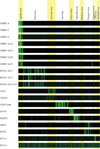Microarray-based detection of viruses causing vesicular or vesicular-like lesions in livestock animals
- PMID: 18621489
- PMCID: PMC4310687
- DOI: 10.1016/j.vetmic.2008.05.030
Microarray-based detection of viruses causing vesicular or vesicular-like lesions in livestock animals
Abstract
Definitive diagnosis of vesicular or vesicular-like lesions in livestock animals presents challenges both for veterinary clinicians and diagnostic laboratories. It is often impossible to diagnose the causative disease agent on a clinical basis alone and difficult to collect ample vesicular epithelium samples. Due to restrictions of time and sample size, once laboratory tests have ruled out foot-and-mouth disease, vesicular stomatitis and swine vesicular disease a definitive diagnosis may remain elusive. With the ability to test a small quantity of sample for a large number of pathogens simultaneously, DNA microarrays represent a potential solution to this problem. This study describes the application of a long oligonucleotide microarray assay to the identification of viruses known to cause vesicular or vesicular-like lesions in livestock animals. Eighteen virus isolates from cell culture were successfully identified to genus level, including representatives of each foot-and-mouth disease virus serotype, two species of vesicular stomatitis virus (VSV), swine vesicular disease virus, vesicular exanthema of swine virus (VESV), bovine herpesvirus 1, orf virus, pseudocowpox virus, bluetongue virus serotype 1 and bovine viral diarrhoea virus 1. VSV and VESV were also identified in vesicular epithelium samples, with varying levels of sensitivity. The results indicate that with further development this microarray assay could be a valuable tool for the diagnosis of vesicular and vesicular-like diseases.
Figures

Similar articles
-
Rapid and differential diagnosis of foot-and-mouth disease, swine vesicular disease, and vesicular stomatitis by a new multiplex RT-PCR assay.J Virol Methods. 2008 Feb;147(2):301-11. doi: 10.1016/j.jviromet.2007.09.010. Epub 2007 Oct 26. J Virol Methods. 2008. PMID: 17964668
-
Diagnostic evaluation of multiplexed reverse transcription-PCR microsphere array assay for detection of foot-and-mouth and look-alike disease viruses.J Clin Microbiol. 2008 Mar;46(3):1081-9. doi: 10.1128/JCM.01740-07. Epub 2008 Jan 23. J Clin Microbiol. 2008. PMID: 18216216 Free PMC article.
-
Microarray-based molecular detection of foot-and-mouth disease, vesicular stomatitis and swine vesicular disease viruses, using padlock probes.J Virol Methods. 2007 Aug;143(2):200-6. doi: 10.1016/j.jviromet.2007.03.004. Epub 2007 Apr 23. J Virol Methods. 2007. PMID: 17451815
-
Diagnosis and screening of foot-and-mouth disease.Comp Immunol Microbiol Infect Dis. 2002 Oct;25(5-6):309-20. doi: 10.1016/s0147-9571(02)00028-0. Comp Immunol Microbiol Infect Dis. 2002. PMID: 12365807 Review.
-
An overview on ELISA techniques for FMD.Virol J. 2011 Sep 4;8:419. doi: 10.1186/1743-422X-8-419. Virol J. 2011. PMID: 21888667 Free PMC article. Review.
Cited by
-
Multiplex RT-PCR and Automated Microarray for Detection of Eight Bovine Viruses.Transbound Emerg Dis. 2017 Dec;64(6):1929-1934. doi: 10.1111/tbed.12591. Epub 2016 Nov 23. Transbound Emerg Dis. 2017. PMID: 27878975 Free PMC article.
-
A multiplex reverse transcription PCR and automated electronic microarray assay for detection and differentiation of seven viruses affecting swine.Transbound Emerg Dis. 2018 Apr;65(2):e272-e283. doi: 10.1111/tbed.12749. Epub 2017 Nov 30. Transbound Emerg Dis. 2018. PMID: 29194985 Free PMC article.
-
Molecular and nanotechnologic approaches to etiologic diagnosis of infectious syndromes.Mol Diagn Ther. 2011 Jun 1;15(3):145-58. doi: 10.1007/BF03256405. Mol Diagn Ther. 2011. PMID: 21766906 Free PMC article. Review.
-
Development of a Feature and Template-Assisted Assembler and Application to the Analysis of a Foot-and-Mouth Disease Virus Genotyping Microarray.PLoS One. 2017 Jan 3;12(1):e0166870. doi: 10.1371/journal.pone.0166870. eCollection 2017. PLoS One. 2017. PMID: 28045937 Free PMC article.
-
Paradigm shift in the diagnosis of peste des petits ruminants: scoping review.Acta Vet Scand. 2020 Jan 29;62(1):7. doi: 10.1186/s13028-020-0505-x. Acta Vet Scand. 2020. PMID: 31996243 Free PMC article.
References
-
- Baner J, Gyarmati P, Yacoub A, Hakhverdyan M, Stenberg J, Ericsson O, Nilsson M, Landegren U, Belak S. Microarray-based molecular detection of foot-and-mouth disease, vesicular stomatitis and swine vesicular disease viruses, using padlock probes. J. Virol. Methods. 2007;143:200–206. - PubMed
-
- Baxi MK, Baxi S, Clavijo A, Burton KM, Deregt D. Microarray-based detection and typing of foot-and-mouth disease virus. Vet. J. 2006;172:473–481. - PubMed
-
- Bohlander SK, Espinosa R, 3rd, Le Beau MM, Rowley JD, Diaz MO. A method for the rapid sequence-independent amplification of microdissected chromosomal material. Genomics. 1992;13:1322–1324. - PubMed
-
- Caraux G, Pinloche S. PermutMatrix: a graphical environment to arrange gene expression profiles in optimal linear order. Bioinformatics. 2005;21:1280–1281. - PubMed
-
- Deregt D, Gilbert SA, Dudas S, Pasick J, Baxi S, Burton KM, Baxi MK. A multiplex DNA suspension microarray for simultaneous detection and differentiation of classical swine fever virus and other pestiviruses. J. Virol. Methods. 2006;136:17–23. - PubMed
Publication types
MeSH terms
Substances
Grants and funding
LinkOut - more resources
Full Text Sources
Other Literature Sources

